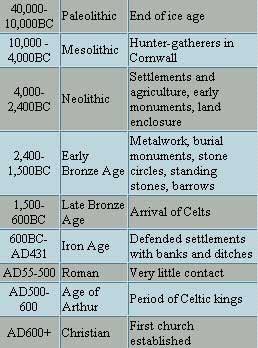|
|
|
Cornwall's earliest history is of special interest, mainly
because many of the structures erected by the first inhabitants
are still in place. Wandering around West Penwith today, you
can find stone field enclosures that date back to the time
of the pyramids, burial sites dating back 5,000 years, stone
circles dating back to the Bronze Age, and even well preserved
ancient villages.
|
|
|

|
Cornwall has always been remote from the rest of England,
originally for geographical reasons. Contact with the Romans
was minimal, though for millennia the inhabitants had contact
with the natives of Brittany, and hence with trading routes
through Europe.
Today Cornwall claims a strong cultural political independence
and local identity, comparable with other Celtic regions of
Britain. The Cornish language, which once died out, has recently
been revived and is taught in schools.
'Celtic' Cornwall represents only a small part of its known
history, which extends from the arrival of agricultural settlers
6,000 years ago, through the eras of the stone monument makers,
to the 19thC when Cornwall produced most of the World's tin.
|
With the coming of the Victorian railways, Cornwall became more
accessible to the rest of England. Nowadays the tin mines have all
closed, and agriculture and fishing are much reduced. The industrial
past has had very little lasting impact on the area's stunning landscape
and coastline, and West Penwith still offers its long and living
history openly and plentifully, along the roadsides and moors.
TOP
|
